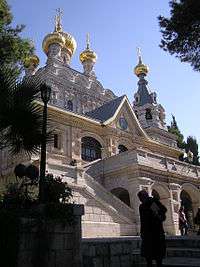Church of Mary Magdalene
| Church of Mary Magdalene | |
|---|---|
.jpg) | |
| Basic information | |
| Location | East Jerusalem |
| Affiliation | Russian Orthodox |
| Year consecrated | 1888 |
| Architectural description | |
| Architect(s) | David Grimm |
| Completed | 1888 |
The Church of Mary Magdalene is a Russian Orthodox church located on the Mount of Olives, near the Garden of Gethsemane in East Jerusalem.
History

The church is dedicated to Mary Magdalene, the companion of Jesus. According to the sixteenth chapter of the Gospel of Mark, Mary Magdalene was the first to see Christ after his resurrection (Mark 16:9). Although equals, she is usually considered a crucial and important disciple of Jesus, and seemingly his primary female associate, along with Mary of Bethany, whom some believe to have been the same woman.[1]

The church was built in 1886 by Tsar Alexander III to honor his mother, Empress Maria Alexandrovna of Russia. It was constructed to David Grimm's design in the traditional tented roof style popular in 16th- and 17th-century Russia, and includes seven distinctive, gilded onion domes. The convent is located directly across the Kidron Valley from the Temple Mount.
The relics of two martyred saints, Grand Duchess Elizabeth Feodorovna of Russia and her fellow nun Varvara Yakovleva, are displayed in the church.[2]
In the 1930s, Princess Alice of Battenberg, mother of the Duke of Edinburgh, visited the church and asked to be buried near her aunt, the Grand-Duchess Elizabeth. In 1969, she died at Buckingham Palace. In 1988, her remains were transferred to a crypt below the church.[3] In 1982 the Russian Church in Exile canonised the new martyrs of the communist revolution and in May the bodies of Elizabeth and Barbara were moved from the crypt where only private veneration was possible to the upper church of St. Mary Magdalene. Since 1981 Elizabeth and Barbara are venerated as ‘new martyrs’ by the Orthodox Church in Exile at St. Mary Magdalene, Gethsemane. A statue of Elizabeth is among those of the twentieth century martyrs above the West Door of Westminster Abbey installed in 1998. In the changed political situation of the 1990s the Moscow Patriarchate considered recognition of the martyrs of this period including the members of the royal family and her status as a saint was also recognized in April 1992 by the Moscow Patriarchate. [4]
See also
References
- ↑ Jansen, Katherine Ludwig (2000). The Making of the Magdalen: Preaching and Popular Devotion in the Later Middle Ages. Princeton University Press. ISBN 978-0691058504.
- ↑ Portrait of a Duke, Tom Segev, Haaretz
- ↑ "Convent of Saint Mary Magdalene - The Garden of Gethsemane". Russian Ecclesiastical Mission in Jerusalem.
- ↑ Teresa Joan White, "History of Women in the Diaconate: Phoebe, Olympias, Radegund and Colleagues, London, 2014, chapter 16a. {Copy at Lambeth Palace Library]
External links
- Official website
- Webpage from Russian Ecclesiastical Mission in Jerusalem
- Virtual tour of church interior
| Wikimedia Commons has media related to Saint Mary Magdalene Church (Jerusalem). |
Coordinates: 31°46′44″N 35°14′28″E / 31.77889°N 35.24111°E